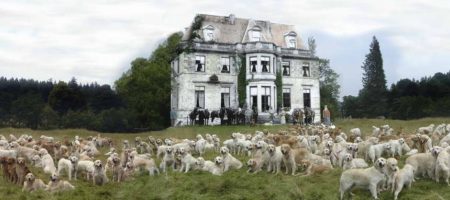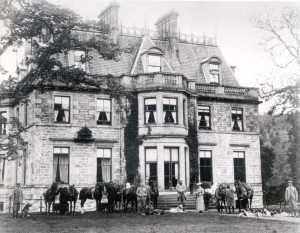Breed History
I think that to know and understand this breed it helps to know the breed’s history. The Golden Retriever is the result of a series of breedings done by Lord Tweedmouth in Scotland at Guisachan House, starting in 1864. Here’s a picture of Guisachan House from years past.
Guisachan House is an estate located in the village Tomich in Scotland. If you consider the harsh winters that this area experiences and its surrounding dense vegetation you may begin to understand why Goldens have such dense undercoats. It was not until 1908 that the breed was first exhibited at the Kennel Club Show, and it immediately created great interest. That public interest has grown steadily over the years, and today Goldens are one of the most popular and multi-purpose dogs to be found. Bear in mind, however, that from the outset the breed was designed to work in the field by day alongside its human companions, and then to snooze by the fireplace in the evening, again alongside its human companions. These dogs were never expected to patrol their grounds alone, or to be separated from their owners for long periods of time.
You will see in these pages some of the different types of Golden Retrievers. While the shade of the coat may vary, it is what is under the coat that matters most. (Trust me, I have had all of the colors, it’s just window dressing.) The body structure and temperament is reflected in detailed breed standards that I believe any ethical breeder should endeavor to uphold. While the standard varies slightly depending on the country, the vast majority of the true attributes are consistent across national borders. That said, in the U.S. one area where there is some variation in the breed standard from the rest of the world is in what is considered the range of acceptable color. In Scotland (the birthplace of Goldens), England, and the rest of Western Europe, as well as in Canada and in Australia, the range of colors includes the light, frequently called cream-colored, Goldens. This light coloring was present among the first dogs bred by Lord Tweedmouth, a point his kennel records clearly establish. The U.S. breed standard nevertheless appears to disapprove of this coloring but gives no explanation for this exclusion. As a result, many people in the U.S. are not accustomed to seeing this shade in the breed, and unfortunately some unscrupulous breeders have taken advantage of the unsuspecting by describing light-colored dogs as “rare.” To the contrary, although the color is perhaps less common in the U.S., given how wide-spread the light color is throughout the rest of the dog world it is anything but rare.

